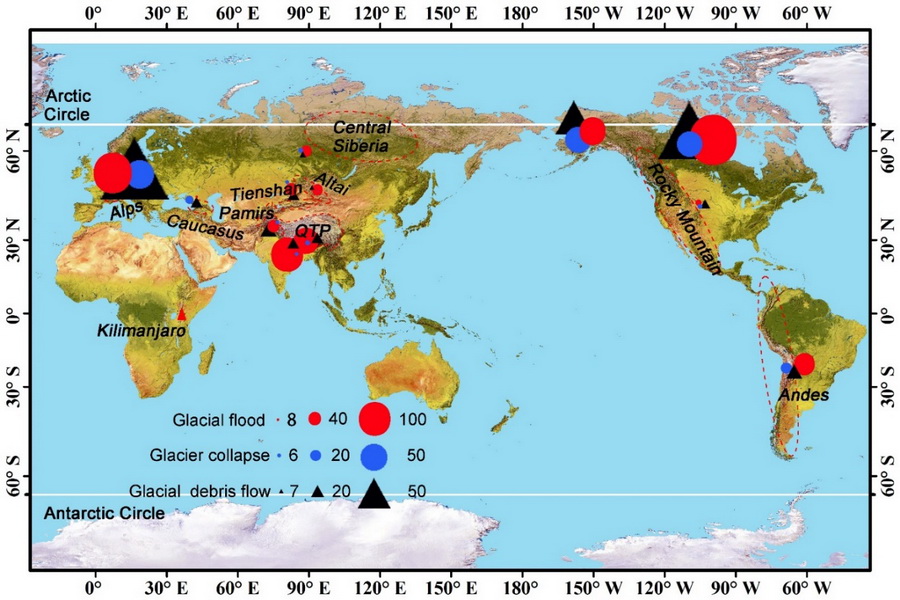Climate Warming Increases Cryospheric Hazards
Updatetime:2021-01-12From:
【Enlarge】【Reduce】
The cryosphere is an important component of the global climate system. In a narrow sense, it mainly refers the glaciers, permafrost, snow cover, and sea ice because these components are continuously distributed below the freezing point with a certain thickness. Cryospheric components are sensitive to climate warming, and changes in the cryosphere can lead to serious hazards to human society.
Recently, Prof. DING Yongjian from the Northwest Institute of Eco-Environment and Resources (NIEER), Chinese Academy of Sciences (CAS) and his research group comprehensively analyzed hazards related to the atmospheric, oceanic and land cryosphere and their phenomena, mechanisms and impacts. They also evaluated the future trends of the risks of cryospheric hazards.
In this study, they found that the recorded frost hazards show a decreasing trend, and the hail hazards distribution showed great heterogeneities in the frequency and magnitude. The frequency of freezing rain events may decrease in the future, but the changes in ice load, duration of freezing rain events remains poorly understood. The probability of cold heavy snowfall, ice storms, and blizzards may increase during the weak polar vortex events.
Therefore, it’s getting more and more difficult to predict hazards from the atmospheric cryosphere in the future, while property loss are expected to increase due to the increases in population density and wealth.
For the hazards from the oceanic cryosphere, they found that the sea ice extent is declining rapidly, making it possible for the human activities extend further into high latitude areas. The iceberg numbers will likely increase, which will increase icebergs hazards.
Besides, the climate change also accelerates the erosion of permafrost-dominated coastlines. Due to the rapid melting of mountain glaciers and ice sheets, the sea level rise is expected to continue in the next decades and will cause threats to low coastal lands.
The hazards from glaciers attracted many attentions (Fig.1). The glacier collapse, glacial lake outburst, and dynamics in recently deglaciated environments will increase in the future because of the melting of the glacier. Although the total area of snow cover shows a decreasing trend with the warming climate, the heavy snow events, snow avalanches, and snowmelt floods will not decrease simultaneously because snowfall has large spatial heterogeneities. The permafrost-related rock and debris flow and thaw slump will increase with permafrost degradation.
In addition, permafrost-dammed lakes in low terrains also at the risk of outbursts due to the rapid thaw of permafrost (Fig. 2).
“It is clear the cryosphere is shrinking, while cryospheric hazards will likely increase in the future,” said DING Yongjian, “Although the cryospheric hazards remain highly uncertain, climate change and destabilization of the cryosphere will exacerbate our social and economic risks. Therefore, the prediction and warning of the hazards are important to minimize harm for human society.”
This work has been published on Earth-Science Reviews recently titled with “Increasing cryospheric hazards in a warming climate”.

Fig.1 Number of publications mentioning glacial hazards (Web of Science, data from 1990 to October 2020). The red dashed lines indicate the high altitudes where land cryosphere widely distributed. The red triangle indicates the Kilimanjaro Mountain in Africa.

Fig. 2 Process and effects of the Zhuonai Lake (a lake in lowland terrain) outbursts on environment and engineering on the Qinghai-Tibetan Plateau
Contact:
DING Yongjian
E-mail: dyj@lzb.ac.cn
Cryosphere Research Station on the Qinghai-Tibetan Plateau, State Key Laboratory of Cryospheric Science, Northwest Institute of Eco-Environment and Resource, Chinese Academy of Sciences, Lanzhou, Gansu 730000, China.
Appendix




